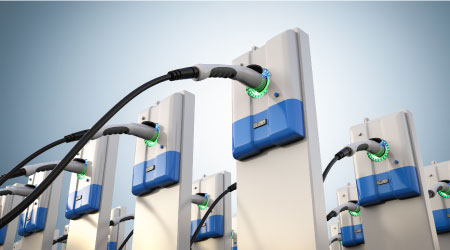How Facilities Should Prepare for the Rapid Growth of Electric Vehicles
Following these four tips to be ready for the exploding demand for electric vehicle charging at your facilities.
By Daniel Colombini and Vinod Palal
Electric vehicles are the future of transportation in America. Their use is growing rapidly, and it’s about to accelerate. Rising gas prices will only increase that acceleration. Facility managers should plan for the accompanying need for charging stations, and the time to start is now.
The demands on facilities will vary depending on the nature of the property, its specific needs, and the expectations of those being served. Does the property provide parking for commuting employees or a commercial fleet? How long is the typical commute or product delivery route? How available are other chargers? Will drivers expect to charge their vehicles at work or at home?
The demands will also continue to evolve. The patterns of today’s early adopters may change as more people switch to electric vehicles. Plans should, therefore, be developed that can be adapted, as more is known. What we already know is that the demand could be fast and furious.
As of 2020, nearly 1.8 million electric vehicles were registered in the United States, and McKinsey & Company reports that U.S. electric vehicle sales “increased nearly 200 percent between the second quarter 2020 and the second quarter 2021.” A recent Pew Research Center survey revealed that “39 percent of U.S. adults said they were very or somewhat likely to seriously consider buying an electric vehicle the next time they’re in the market for new wheels.”
Future sales growth could be fueled further by federal action. The U.S. Infrastructure Investment and Jobs Act, enacted in November, includes $7.5 billion to build out the first-ever national network of electric vehicle chargers in the United States. That is part of a broader national agenda to reduce carbon emissions, which includes a goal that half of all new vehicles sold in the United States will be zero-emissions vehicles, including electric or plug-in hybrids by 2030.
New developments will, therefore, unfold soon, and momentum has likely grown even since November. Recent world events have heightened the volatility of gas prices and restricted the sources of oil. The appeal of electric vehicles is only enhanced by comparison.
Four Steps to EVs
How then should facility managers prepare? There are four steps to take:
First, consider the nature and needs of each existing property in the context of future electric vehicle use. How many existing parking spaces are there? How close are those spaces to the electrical infrastructure? What will be the likely demand for electric vehicle charging?
Also consider the marketing benefits of offering sufficient electric vehicle chargers to potential tenants – both to meet their needs and to underscore the property’s commitment to the environment. Prominently placed electric vehicle chargers provide a valuable service and make a compelling statement. The most important thing now is to start focusing on the likely needs.
Second, if the anticipated needs are substantial, survey the infrastructure. Secure professional assistance in evaluating the existing electrical infrastructure and what would be required to adapt that infrastructure to meet the anticipated needs for electric vehicle charging. Most properties have some existing infrastructure capacity to serve a small percentage of their existing parking spaces with electric vehicle charging. That can typically be done without a service upgrade.
The magnitude – and cost – of any upgrade to meet anticipated demand will depend on several factors. They include the capacity of the electrical service upgrade, the distance from existing electrical service to the sites where the chargers will be needed, whether digging trenches will be required, and any local law requirements.
In New York City, for instance, Local Law 130 of 2013 requires that any parking garages or parking lots that make electrical modifications must include the electrical capacity needed to make at least 20 percent of the parking spaces suitable for electric vehicles. There is also proposed legislation in the City Council to amend this to require parking garages and parking lots to have at least 40 percent of their parking spots powered for electric vehicles by 2030. This would apply retroactively to all such properties.
Third, determine the estimated cost of any needed upgrade. The cost has three primary factors: the upfront infrastructure upgrade required; the extent of financial incentives available, and the potential for the upfront cost to be reimbursed over time through a nominal surcharge (perhaps 10 cents per hour per charge) beyond the energy consumption used by each vehicle serviced.
Chargers on commercial properties would typically be Level 2 chargers, which can provide around 32 miles of range per hour of charging. That’s about twice as fast as a Level 1 residential charger.
Fortunately, government and utility incentives are often available and can cover 50% or more of the cost. The size and extent of incentives are determined by the location and type of property.
In New York City and the surrounding region served by Con Edison, for instance, incentives from the New York State Energy Research and Development Authority (NYSERDA) and Con Edison can reduce the upfront cost significantly. Con Edison’s rebate per electric vehicle charger port can be as much as $11,200.
Fourth, anticipate and meet the need. Based on the size of the required infrastructure upgrade and the anticipated cost, develop a staged plan for meeting the need at the appropriate time. Determine how many electric vehicle chargers will be required and when. Then activate the plan so that the property is always ahead of demand but not by more than necessary.
Facility managers should take these four steps to ensure that each property is ahead of the demand. Electric vehicle chargers will be expected at properties nationwide, and, while the precise timing is hard to predict, the sequencing of these steps will enable sufficient capacity.
The transition to electric vehicles is a vital national priority – to reduce carbon emissions and decrease dependence on foreign oil. Facility managers have a crucial role to play in helping the nation charge ahead.
Daniel Colombini and Vinod Palal are Principals at the New York City-based consulting engineering firm Goldman Copeland.
Related Topics:












